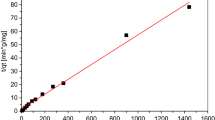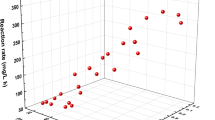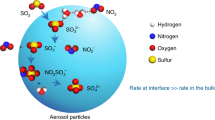Abstract
SULPHUR and nitrogen oxides emitted by the combustion of fossil fuels in power plants have an important role in acid-rain production1. Most of the flue-gas desulphurization scrubbers installed to date involve wet limestone processes, which are efficient in SO2 control but are incapable of removing nitric oxide. Here we report a new and efficient method for the combined removal of SO2and NOX from flue gas, using aqueous emulsions containing yellow phosphorus and an alkali. The products comprise sulphate, nitrate and phosphate salts which can be used as fertilizer materials. The process described here may also be applied to stationary sources other than power plants, such as smelters, nitric acid plants and municipal incinerators for NOX control.
This is a preview of subscription content, access via your institution
Access options
Subscribe to this journal
Receive 51 print issues and online access
$199.00 per year
only $3.90 per issue
Buy this article
- Purchase on Springer Link
- Instant access to full article PDF
Prices may be subject to local taxes which are calculated during checkout
Similar content being viewed by others
References
Wark, K. & Warner, C. F. Air Pollution-Its Origin and Control (Harper & Row New York, 1981).
Cosby, B. J. et al. Environ. Sci. Technol. 19, 1144–1149 (1985).
Hileman, B. Environ. Sci. Technol. 18, 8A–10A (1984).
Yaverbaum, L. H. Nitrogen Oxides Control and Removal (Noyes Data Corp., New Jersey, 1979).
Chang, S. G. in Fossil Fuels Utilization: Environmental Concerns (eds Markuszewski, R. & Blaustein, B. D.) 159–175 (American Chemical Soc., Washington, DC, 1986).
Liu, D. K., Frick, L. P. & Chang, S. G. Environ. Sci. Technol. 22, 219–223 (1988).
Liu, D. K. & Chang, S. G. Environ. Sci. Technol. 22, 1196–1200 (1988).
Chang, S. G., Littlejohn, D. & Liu, D. K. Ind. Eng. Chem. Res. 27, 2156–2161 (1988).
Zhuang, Y. & Deng, Y. Acta Sci. Circumstantiae 5, 347–353 (1985).
Bedell, S. A., Tsai, S. S. & Grinstead, R. R. Ind. Eng. Chem. Res. 27, 2092–2095 (1988).
Littlejohn, D. & Chang, S. G. Analyt. Chem. 59, 158–160 (1986).
Chang, S. G., Littlejohn, D. & Lin, N. H. in Flue Gas Desulfurization (eds Hudson, J. L. & Rochelle, G. T.) 127–152 (American Chemical Soc., Washington, DC, 1982).
Huffman, E. O. in Kirk-Othmer Encyclopedia of Chemical Technology Vol. 10, 3rd edn (eds Bushey, G. J. et al.) 31–125 (Interscience, New York, 1980).
Cordes, H. & Witschel, W. Z. phys. Chem. 46, 35–48 (1965).
VanZee, R. J. & Khan, A. U. J. chem. Phys. 65, 1764–1772 (1976).
Andrews, L. & Withnall, R. J. Am. chem. Soc. 110, 5605–5611 (1988).
Chemical Marketing Reporter, 7 November 1988, pp. 34–44.
Eskinazi, O. D. & Cichanowicz, J. E. J. Air Pollution Control Ass. 39, 1131–1139 (1989).
Author information
Authors and Affiliations
Rights and permissions
About this article
Cite this article
Chang, S., Liu, D. Removal of nitrogen and sulphur oxides from waste gas using a phosphorus/alkali emulsion. Nature 343, 151–153 (1990). https://doi.org/10.1038/343151a0
Received:
Accepted:
Issue Date:
DOI: https://doi.org/10.1038/343151a0
This article is cited by
-
Performance characteristics of NO removal by cobalt diethylenetriamine solution
Korean Journal of Chemical Engineering (2010)
-
In search of a recyclable sulphur dioxide sponge?a new look at an old system
Environmental Monitoring and Assessment (1991)
Comments
By submitting a comment you agree to abide by our Terms and Community Guidelines. If you find something abusive or that does not comply with our terms or guidelines please flag it as inappropriate.



